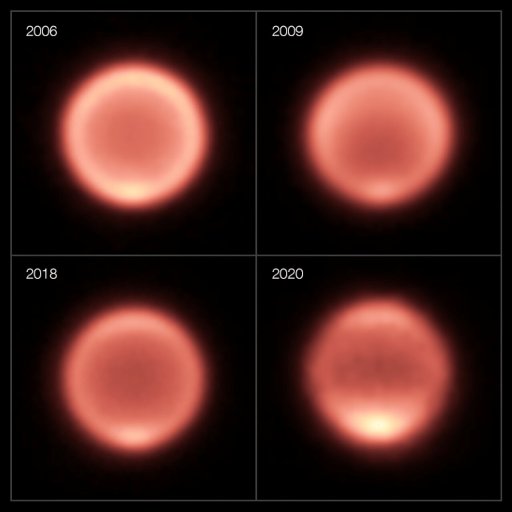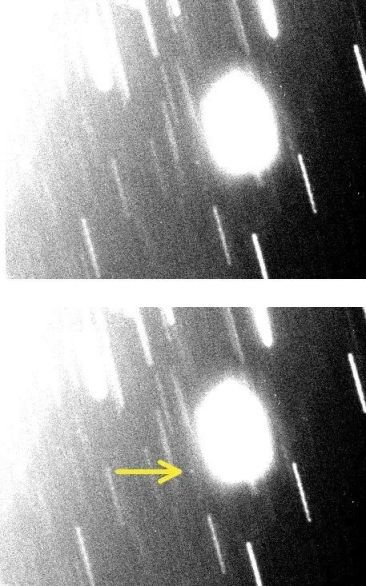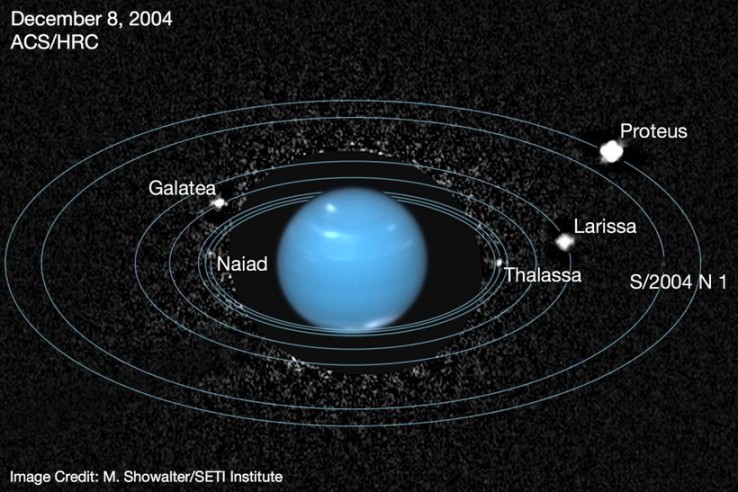The James Webb Space Telescope recently took aim at the strange and mysterious Uranus, a side-rotating ice giant. What Webb discovered was a dynamic world with rings, moons, storms and other atmospheric features, including a seasonal polar cap. With his exceptional sensitivity, Webb captured images of Uranus’ faint inner and outer rings, including the elusive Zeta Ring, the extremely faint and diffuse ring closest to the planet. He also took pictures of many of the planet’s 27 known moons, even seeing some of the smaller moons inside the rings.
Uranus
At visible wavelengths, Uranus appeared as a calm, solid blue ball. In infrared wavelengths, Webb reveals a strange and dynamic icy world filled with fascinating atmospheric features. One of the most striking of these is the planet’s seasonal northern polar cap. Compared to the image taken earlier this year, these new images make it easier to see some of the details of this hat. These include a bright white inner cap and a dark stripe at the bottom of the polar cap, towards lower latitudes.

The image expands on the two-color version released earlier this year, adding additional wavelength coverage for more detailed viewing. NASA/ESA/CSA
Several bright storms can also be seen near and below the southern edge of the polar cap. The number of these storms, as well as how often and where they appear in Uranus’s atmosphere, may be due to a combination of seasonal and meteorological effects. The polar cap becomes visible when the planet’s pole faces the Sun, approaches the solstice, and receives more sunlight. Uranus will reach its next solstice in 2028, and astronomers are eagerly awaiting any possible changes in the structure of these objects. Webb will help unravel the seasonal and meteorological effects affecting Uranus’ storms, which is critical to understanding the planet’s complex atmosphere.
Thanks to Webb’s unprecedented infrared resolution and sensitivity, astronomers are now seeing Uranus and its unique features with revolutionary clarity. These details, especially about the immediate ring, will be invaluable for planning any future missions to Uranus, especially proposed orbiters and probes. Scientists want to bring any spacecraft as close to the planet as possible to measure Uranus’ gravitational field and better analyze its atmosphere. However, such a close approach will need to be carefully planned to avoid collisions with any possible debris from the ice and dust rings.
Uranus can also serve as a proxy for the study of many distant exoplanets of similar size discovered over the past few decades. This “exoplanet in our backyard” could help astronomers understand how planets this size work, their meteorology, and how they formed. This, in turn, can help us understand our solar system as a whole, placing it in a broader context.
Neptune
Astronomers have for the first time reliably identified subseasonal variability in the properties of Neptune’s stratosphere, using data from 17 years of observations of the ice giant using ground-based and space telescopes. It turned out that during half of the Neptunian summer, the planet’s stratosphere in the middle and temperate latitudes gradually cooled, and the south pole warmed sharply over the past three years.
Neptune is the most distant giant planet from the Sun, but it has an extremely dynamic atmosphere in which powerful zonal winds operate, and significant evolution of meteorological phenomena, such as high-altitude clouds, can occur on a time scale of several days. In addition, changes in Neptune’s albedo may be observed over several years, as well as the appearance of long-lived clouds and dark vortices.
A team of astronomers led by Michael Roman from the University of Leicester in the UK has published the results of an analysis of mid-infrared observations of Neptune from 2003 to 2020 using the VISIR (VLT Imager and Spectrometer for mid-InfraRed) instrument. , installed on the VLT ground-based telescope, the Spitzer Space Telescope and the ground-based telescopes Subaru, Keck, Gemini North and Gemini South. The goal of the work was to identify long-term and seasonal fluctuations in the temperature and chemical composition of Neptune’s atmosphere.

Thermal images of Neptune taken between 2006 and 2020. ESO,NAOJ/Subaru/COMICS
It was summer in Neptune’s southern hemisphere in 2005, but between 2003 and 2018 the average temperature of the stratosphere decreased, affecting the emission of molecular hydrogen, methane, ethane, and deuterated methane (CH3D). The meridional temperature contrast between the more southerly pole and the equator has increased from about 8 Kelvin in 2003 to 28 Kelvin in 2020. At the same time, in the period from 2018 to 2020, a sharp warming of the stratosphere was observed near the south pole of Neptune – the temperature increased from 152 to 163 kelvin. This showed up as an increase in the brightness of the southern polar region, while the planet’s mid- and low-latitude regions remained dimmer than in previous observation years.
Scientists have concluded that they have the strongest evidence to date that Neptune is subject to processes that generate subseasonal atmospheric variability on both global and regional scales. At the same time, the physical mechanism connecting stratospheric temperatures, tropospheric clouds and fogs at different altitudes is still unknown, but may be associated with the change of seasons, weather changes or variations in the flux of solar radiation.
New satellites of Uranus and Neptune
Scientists at the Carnegie Institution for Science, in collaboration with observatories around the world, have discovered three new moons in the outer solar system: one orbiting Uranus and two orbiting Neptune. These moons are tiny: the largest of the three moons is only 15 miles in diameter. These moons have been discovered (in some cases) for several years, and a special imaging technique was required to separate them from the stellar background.
Three new moons—one orbiting Uranus and the other two orbiting Neptune—were discovered by researchers at the Carnegie Institution for Science. Thus, the number of moons of the outer planets is 28 and 16, respectively. Because Uranus and Neptune are further away than their gas giant cousins, they are harder to imagine (and much harder to visit). “The three newly discovered moons are the smallest ever discovered around these two icy giant planets using ground-based telescopes,” Scott Sheppard of Carnegie Science said in a press statement. “Special image processing was required to detect such objects.”

An example of a deep imaging technique showing Uranus’ new moon S/2023 U1 on November 4, 2023 (the faint point of light indicated by the arrow). Other light sources are trails from the background stars.
A new addition to the Uranus collection, now 20 years old, is S/2023 U1. The Moon was originally discovered by Sheppard on November 4, 2023, using the Magellan Telescopes at Las Campanas Observatory in Chile. The moon is especially small—just five miles across, making it the smallest of Uranus’ moons—and takes 680 days to orbit the planet.
Neptune’s other two moons come in two varieties: bright and dim. The bright star, now known as S/2002 N5, has a diameter of 15 miles and orbits Neptune every 9 years. The fainter one, S/2021 N1, is 9.3 miles in diameter, orbits every 27 years, and was a little harder to spot.
The European Southern Observatory’s Very Large Telescope and Gemini Observatory’s 8-meter telescope needed ultra-clear nights to track the tiny moon’s orbit. Both of these moons were initially discovered back in September 2021 and confirmed by subsequent observations in subsequent years using Magellan telescopes. Both of Neptune’s newest additions will be named after the 50 Nereid sea goddesses from Greek mythology.

To view deeper images of Uranus and Neptune than ever before, astronomers used five-minute exposures over three to four hour periods over several nights. Thanks to the motion of the planets, this technique produced more detail than any previous survey of the ice giants.
“Because satellites move for only a few minutes relative to background stars and galaxies, single long exposures are not ideal for capturing deep images of moving objects,” Sheppard said in a press statement. “When these multiple exposures are stacked together, stars and galaxies will appear with trails behind them, and moving objects similar to the host planet will be seen as point sources, making the moons stand out due to background noise in the images.”
The orbits of these three moons suggest that they likely orbited these icy planets shortly after their formation in the early days of the solar system. Understanding these orbital characteristics can help astronomers understand how these distant planets captured their moons.




